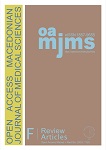The Effectiveness of Video Observed Therapy towards Compliance with Drug throughout Tuberculosis Patients
DOI:
https://doi.org/10.3889/oamjms.2023.11050Keywords:
Video, Adherence, TuberculosisAbstract
BACKGROUND: Treatment of tuberculosis is carried out every day in the long-term, causing boredom to take medication and reducing medication adherence. Taking medication that is not routine causes drug resistance which can cause tuberculosis treatment to take longer.
AIM: This study aims to review the effect of the application of drug-taking supervisors on drug adherence in tuberculosis patients.
METHODS: The research design uses the preferred reporting items for systemic review and meta-analysis Guidelines with an online literature search strategy using the Google chrome search engine Scopus, Science Direct, PubMed, CINAHL, and Proquest. The year of the literature source was taken from 2018 to 2022. From the articles searched, five articles were obtained and reviewed.
RESULTS: The results of a review of five articles showed that video observed therapy (VOT) technology was needed to improve medication adherence in tuberculosis patients.
CONCLUSION: This review shows the role of VOT technology to improve medication adherence in tuberculosis patients.Downloads
Metrics
Plum Analytics Artifact Widget Block
References
CDC. Treatment for TB Disease [WWW Document]. U.S. Department of Health and Human Services; 2022. Available from: https://www.cdc.gov/tb/topic/treatment/tbdisease.htm [Last accessed on 2022 Jun 23].
Osterberg L, Blaschke T. Adherence to medication. N Engl J Med. 2005;353(5):487-97. https://doi.org/10.1056/NEJMra050100 PMid:16079372 DOI: https://doi.org/10.1056/NEJMra050100
Rolnick SJ, Pawloski PA, Hedblom BD, Asche SE, Bruzek RJ. Patient characteristics associated with medication adherence. Clin Med Res. 2013;11(2):54-65. https://doi.org/10.3121/cmr.2013.1113 PMid:23580788 DOI: https://doi.org/10.3121/cmr.2013.1113
Zegeye A, Dessie G, Wagnew F, Gebrie A, Islam SM, Tesfaye B, et al. Prevalence and determinants of anti-tuberculosis treatment non-adherence in Ethiopia: A systematic review and meta-analysis. PLoS One. 2019;14:1-15. https://doi.org/10.1371/journal.pone.0210422 PMid:30629684 DOI: https://doi.org/10.1371/journal.pone.0210422
World Health Organization. Global Tuberculosis Report. Switzerland: World Health Organization; 2020.
Kementrian Kesehatan RI. Profil Kesehatan Indonesia Tahun. Indonesia: Kementrian Kesehatan RI; 2019. p. 497.
Falzon D, Raviglione M, Bel EH, Gratziou C, Bettcher D, Migliori GB. The role of eHealth and mHealth in tuberculosis and tobacco control: A WHO/ERS consultation. Eur Respir J. 2015;46(2):307-11. https://doi.org/10.1183/09031936.00043315 PMid:26232477 DOI: https://doi.org/10.1183/09031936.00043315
WHO. Target Product Profiles for Digital Health Products for the End TB Strategy; 2022. Available from: https://www.erj.ersjournals.com/content/erj/suppl/2016/05/26/13993003.00424-2016.dc1/erj-00424-2016_supplement.pdf [Last accessed on 2022 Jun 23].
Soler HO, Thomas D, Joglar O, Rios K, Rodriguez MT, Guzman GD, et al. Notes from the field. Morb Mortal Wkly Rep. 2020;82:3-6. https://doi.org/10.1080/00182370.2020.1723969 DOI: https://doi.org/10.1080/00182370.2020.1723969
Garfein RS, Liu L, Cuevas-Mota J, Collins K, Catanzaro DG, Muñoz F, et al. Evaluation of recorded video observed therapy for anti-tuberculosis treatment. Int J Tuberc Lung Dis. 2020;24(5):520-5. https://doi.org/10.5588/ijtld.19.0456 PMid:32398202 DOI: https://doi.org/10.5588/ijtld.19.0456
Volmink J, Garner P. Directly observed therapy for treating tuberculosis (review). Cochrane Database Syst Rev. 2003;(1):CD003343. https://doi.org/10.1002/14651858.CD003343 DOI: https://doi.org/10.1002/14651858.CD003343
Alipanah N, Jarlsberg L, Miller C, Linh NN, Falzon D, Jaramillo E, et al. Adherence interventions and outcomes of tuberculosis treatment: A systematic review and meta-analysis of trials and observational studies. PLoS Med. 2018;15(7):e1002595. https://doi.org/10.1371/journal.pmed.1002595 PMid:29969463 DOI: https://doi.org/10.1371/journal.pmed.1002595
Friedena TR, Sbarbarob JA. Promoting adherence to treatment for tuberculosis: The importance of direct observation. Bull World Health Organ. 2007;85(5):407-9. https://doi.org/10.2471/BLT.06.038927 PMid:17639230 DOI: https://doi.org/10.2471/BLT.06.038927
Moola S, Munn Z, Tufanaru C, Aromataris E, Sears K, Sfetcu R, et al. Checklist for RCTs. South Australia: The Joanna Briggs Institute; 2017.
Yamazaki M. Guidelines for Treatment of Drug-Susceptible Tuberculosis and Patient Care, Kekkaku. Switzerland: World Health Organization; 2017.
Putri JP. Effect of providing drug information with the media video on medication adherence in diabetes mellitus patients Type 2 at the Ungaran Health Center. J Chem Inf Model. 2020;21:1-9.
Elsandi S. The effect of video based hypertension education on hypertension medicine comliance in the elderly in the work area of the health. Politek Kesehat Kemenkes Bengkulu. 2021;4:6.
Downloads
Published
How to Cite
Issue
Section
Categories
License
Copyright (c) 2023 Lie Liana Fuadiati, Tintin Sukartini, Makhfudli Makhfudli (Author)

This work is licensed under a Creative Commons Attribution-NonCommercial 4.0 International License.
http://creativecommons.org/licenses/by-nc/4.0







